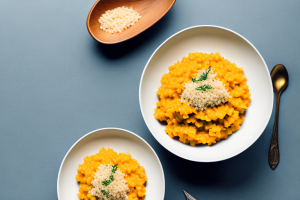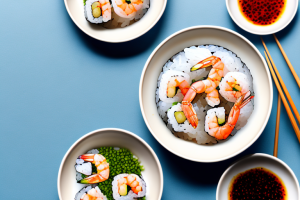How to stir-fry quinoa rice with sesame ginger sauce
8 min read
A pan of quinoa rice being stir-fried with sesame ginger sauce
If you’re looking for a tasty and healthy way to incorporate more whole grains into your diet, look no further than quinoa rice. In addition to being rich in protein and fiber, quinoa rice also has a deliciously nutty flavor that makes it an excellent base for a stir-fry.
The health benefits of quinoa rice
Quinoa rice is a whole grain that has gained popularity in recent years for its many health benefits. Not only is it a good source of protein and fiber, but it also contains a wide variety of vitamins and minerals, including iron, magnesium, and zinc. Additionally, quinoa rice is naturally gluten-free, making it a great option for those with celiac disease or gluten sensitivity.
Another benefit of quinoa rice is that it has a low glycemic index, which means it doesn’t cause a rapid spike in blood sugar levels. This makes it a good option for people with diabetes or those trying to manage their blood sugar levels. Quinoa rice is also high in antioxidants, which can help protect against chronic diseases such as cancer and heart disease.
Quinoa rice is also versatile and can be used in a variety of dishes, from salads to stir-fries to breakfast bowls. It has a nutty flavor and a slightly chewy texture, making it a satisfying addition to any meal. With all of its health benefits and culinary versatility, it’s no wonder that quinoa rice has become a popular choice for health-conscious consumers.
Why stir-frying is a healthy cooking method
Stir-frying is a great way to prepare healthy meals quickly and easily. Unlike other cooking methods, such as deep-frying or pan-frying, stir-frying uses minimal oil and allows you to cook your food for a short amount of time at a high temperature, helping to retain its nutrients and flavor. Additionally, stir-frying is a great way to incorporate more vegetables and whole grains into your meals, as they can be easily added to the stir-fry alongside your protein of choice.
Another benefit of stir-frying is that it can help you reduce your calorie intake. Since stir-frying requires minimal oil, it can help you cut down on excess calories and unhealthy fats. Additionally, by incorporating more vegetables and whole grains into your stir-fry, you can increase your fiber intake, which can help you feel fuller for longer and reduce your overall calorie intake throughout the day.
The versatility of sesame in cooking
Sesame is a versatile ingredient that can be used in a variety of dishes, from sauces and dressings to marinades and stir-fries. Not only does it add a nutty flavor to your food, but it also contains healthy fats and antioxidants that can provide a wide range of health benefits. When using sesame in cooking, it’s important to use high-quality sesame oil, as well as toasted sesame seeds for added texture and flavor.
One of the lesser-known uses of sesame in cooking is in baking. Sesame seeds can be ground into a fine powder and used as a substitute for flour in certain recipes, such as cakes and cookies. This not only adds a unique flavor to the baked goods, but it also makes them gluten-free and adds extra nutrients. Additionally, sesame paste, also known as tahini, can be used as a substitute for butter or oil in certain recipes, such as brownies and muffins, for a healthier twist on traditional baked goods.
Understanding the nutritional value of ginger
Ginger is a root vegetable that has been used for centuries for its many health benefits. In addition to being a natural anti-inflammatory, ginger is also a good source of antioxidants and has been shown to help alleviate symptoms of nausea, menstrual cramps, and arthritis. When using ginger in cooking, it’s important to grate it finely and cook it over low heat to avoid burning or overpowering the other flavors in your dish.
Recent studies have also shown that ginger may have potential benefits for brain function and may even help reduce the risk of developing Alzheimer’s disease. This is due to the presence of compounds in ginger that have been shown to protect against oxidative stress and inflammation in the brain.
Furthermore, ginger has been found to have anti-cancer properties, with some studies suggesting that it may help inhibit the growth of certain types of cancer cells. However, more research is needed in this area to fully understand the potential benefits of ginger for cancer prevention and treatment.
The importance of using high-quality ingredients
When making any dish, it’s important to use high-quality ingredients in order to maximize its flavor and nutritional value. This is especially true when making a stir-fry, as the ingredients are cooked quickly and need to be able to stand up to the heat without losing their texture or taste. When making a quinoa rice stir-fry with sesame ginger sauce, be sure to use fresh vegetables, high-quality protein, and whole grain quinoa rice to ensure the best possible result.
Using high-quality ingredients not only enhances the taste and texture of your dish, but it also provides more nutritional benefits. Fresh vegetables and whole grains are packed with vitamins, minerals, and fiber that are essential for a healthy diet. Additionally, choosing high-quality protein sources such as tofu, tempeh, or grass-fed beef can provide important nutrients like iron and omega-3 fatty acids. By investing in quality ingredients, you are not only improving the taste of your dish, but also the overall health benefits it provides.
How to properly prepare quinoa rice for stir-frying
Before adding your quinoa rice to the stir-fry, it’s important to properly cook and cool it in order to prevent it from sticking together in the pan. To do this, rinse your quinoa rice thoroughly in cold water before cooking it in a ratio of 2 cups of water to 1 cup of quinoa rice. Once the quinoa rice is cooked, spread it out on a baking sheet to cool completely before adding it to your stir-fry.
Another important tip for preparing quinoa rice for stir-frying is to add some oil to the pan before adding the rice. This will help to prevent the rice from sticking to the pan and will also add some extra flavor to your dish. You can use any type of oil that you prefer, such as olive oil or sesame oil.
Additionally, you can add some extra vegetables to your stir-fry to make it even more nutritious and flavorful. Some great options include bell peppers, broccoli, carrots, and snap peas. Simply chop up your vegetables and add them to the pan along with your quinoa rice. Stir-fry everything together until the vegetables are tender and the rice is heated through.
Tips for achieving the perfect stir-fry texture
When making a stir-fry, it’s important to achieve the right balance of textures to ensure a satisfying and delicious result. To do this, be sure to cut your vegetables and protein into evenly sized pieces, and cook each ingredient separately in the pan before adding them all together at the end. Additionally, be sure to stir-fry each ingredient over high heat for a short amount of time in order to prevent overcooking.
Another important tip for achieving the perfect stir-fry texture is to use the right type of oil. It’s best to use an oil with a high smoke point, such as peanut or vegetable oil, as these oils can withstand the high heat required for stir-frying without burning. Additionally, adding a small amount of cornstarch to your protein before cooking can help to create a crispy, golden-brown exterior.
Finally, don’t be afraid to experiment with different sauces and seasonings to add flavor and depth to your stir-fry. Soy sauce, oyster sauce, and hoisin sauce are all popular choices, but you can also try adding ginger, garlic, or chili flakes for a spicy kick. Just be sure to add your sauce and seasonings towards the end of the cooking process, so that they don’t burn or become too overpowering.
Creating the perfect balance of flavors with sesame ginger sauce
The key to a delicious quinoa rice stir-fry is all in the sauce. To make a flavorful and well-balanced sesame ginger sauce, mix together high-quality sesame oil, soy sauce, rice vinegar, honey, grated ginger, and garlic in a small bowl. Be sure to taste the sauce as you go, adding more of any ingredient as needed to achieve the desired flavor.
How to make your own homemade sesame ginger sauce
If you prefer to make your own sesame ginger sauce from scratch, start by toasting sesame seeds in a dry pan over medium-high heat until they are golden brown and fragrant. Then, let the toasted sesame seeds cool before blending them in a food processor or blender with grated ginger, garlic, soy sauce, rice vinegar, and honey until smooth. Slowly pour in high-quality sesame oil while blending the ingredients together until the sauce is thick and creamy.
Adding vegetables to your quinoa rice stir-fry for added nutrition
In addition to quinoa rice, a stir-fry is a great way to incorporate a variety of vegetables into your diet. Not only do vegetables provide important nutrients and fiber, but they also help to add color, texture, and flavor to your dish. Some great vegetables to add to your quinoa rice stir-fry include bell peppers, broccoli, snow peas, and carrots.
Substituting different grains for quinoa rice in this recipe
If you prefer to use a different grain in your stir-fry, there are plenty of options to choose from. Brown rice, basmati rice, and couscous are all great alternatives to quinoa rice, and can be cooked and prepared in a similar way. Additionally, you can experiment with using different types of whole grains, like farro or barley, to add variety to your meals.
Meal prepping and storing leftover quinoa rice stir-fry
If you’re looking to save time during the week, meal prepping a quinoa rice stir-fry is a great option. Simply cook your quinoa rice and chop your vegetables and protein ahead of time, then store them in separate containers in the fridge until you’re ready to cook. When it’s time to make your stir-fry, simply stir-fry each ingredient separately in the pan before combining them all together with your sesame ginger sauce. Leftovers can be stored in an airtight container in the fridge for up to 4 days.
Serving suggestions and pairings for this dish
A quinoa rice stir-fry with sesame ginger sauce is a delicious and filling meal that can be served on its own or paired with a variety of side dishes. Some great options include steamed edamame, a side salad with a citrus dressing, or a refreshing cucumber and tomato salad. Pair your stir-fry with your favorite beverage, like a green tea or a fruity iced tea, for a complete meal that’s sure to impress.
Frequently asked questions about quinoa rice and stir-frying techniques
If you’re new to quinoa rice or stir-frying, you may have some questions about how to properly prepare and cook your ingredients. Here are some frequently asked questions that may help:
- Q: Can quinoa rice be cooked ahead of time and stored in the fridge?
- A: Yes, cooked quinoa rice can be stored in an airtight container in the fridge for up to 4 days.
- Q: How do you prevent your stir-fry from sticking to the pan?
- A: Be sure to heat your pan on high heat before adding your oil. Additionally, try not to overcrowd your pan, as this can cause the ingredients to steam rather than stir-fry.
- Q: Can I use frozen vegetables in my stir-fry?
- A: Yes, frozen vegetables can be a great alternative to fresh vegetables in a pinch. Just be sure to thaw them before adding them to your stir-fry.


